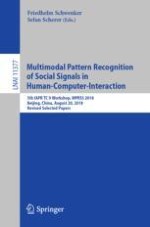2019 | Book
Multimodal Pattern Recognition of Social Signals in Human-Computer-Interaction
5th IAPR TC 9 Workshop, MPRSS 2018, Beijing, China, August 20, 2018, Revised Selected Papers
Editors: Prof. Dr. Friedhelm Schwenker, Stefan Scherer
Publisher: Springer International Publishing
Book Series : Lecture Notes in Computer Science
